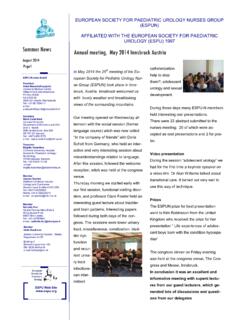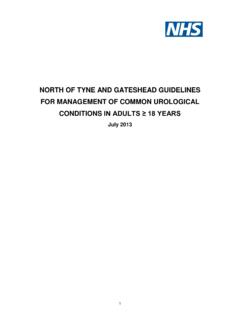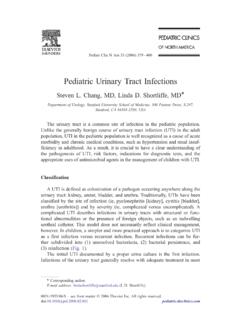Transcription of Management of Children with Priapism and Sickle Cell ...
1 Management of Children with Priapism and Sickle Cell Disease: Joint paediatric and urology clinical guidelines Document Information Version: 3 Date: Dec 2013. Professor David Rees, Dr Sue Height, consultant paediatric haematologists Authors (incl. job title): Responsible Child Health clinical Governance & Risk Committee committee Review date: Dec 2015. Target audience: Haematologists, paediatricians, paediatric urologists Haematologists, paediatricians, paediatric urologists Stakeholders/. committees involved in guideline development : For Child Health clinical guidelines Groups' use only Assessed by: Child Health clinical guidelines Group Assessment date: Approved by : Child Health Governance and Risk Committee Approval Date Author notified: For Trust clinical guidelines Groups' use only Ratified by: Date ratified: Reference No.
2 : Date when guideline comes into effect: Document History Document replaces: Joint paediatric and urology clinical guidelines for the Management of Children with Priapism and Sickle Cell Disease 2. Consultation distribution (before ratification). Sent to Version Date Actions taken as a result Mr Arash Taghazideh, Dec Consultant 3 Changes in contact details. 2013. paediatric Urologist ECH. Mrs Kalpana Patil Dec Consultatn 3 Agrees with new version 2013. paediatric Urologist ECH. Dec Dr Baba Inusa 3 No changes to current version 2013. Reviews and updates (including CGG comments). Date New Summary of Changes Author of change/s version no. Dissemination schedule (after ratification).
3 Target Method Person responsible audience(s). KCH paediatric guidelines on Cliniweb KCH guidelines staff South Thames Sickle and Thalassaemia paediatric Teams in Sue Height and Network on website South Thames Administrator Management of Children with Priapism and Sickle Cell Disease: Joint paediatric and urology clinical guidelines Abstract Page This guideline is relevant to all Children in King's College Hospital with Sickle Cell Disease and Priapism . The guideline applies to all patients with Sickle cell disease who are currently under the care of the paediatric Haematology team. It is mainly aimed at being a tool for the medical team managing these patients, but any member of the multidisciplinary team may find it useful.
4 Background Priapism is a sustained, painful, and unwanted erection. It is classified into a) prolonged if it lasts more than three hours or b) stuttering if it lasts for more than a few minutes but less than three hours; stuttering episodes may recur and/or develop into more prolonged episodes. Priapism is common in Sickle cell disease and as many as 90% of males with SCD will have experienced one or more episodes by the age of 20 years. Priapism in SCD is due to vaso-occlusion, which causes obstruction of the venous drainage of the penis. Prolonged Priapism is an emergency that requires urologic intervention. Contents of guideline Psychosocial and Counselling Aspects of Priapism Height, Sue 27/12/13 11:12.
5 Deleted: Definition/Background Pre Requisites for Practitioner Indications Contra-Indications Equipment required Guideline steps Evaluation and Treatment Episodes lasting less than 2 hours Episodes lasting more than 2 hours Future Prevention Patient Pathway for Priapism Lasting more than 2 hours Patient information References Version: 3 - Management of Children with Priapism and Sickle Cell Disease: Joint paediatric and 1. urology clinical guidelines December 2013. Management of Children with Priapism and Sickle Cell Disease: Joint paediatric and urology clinical guidelines Management of Children with Priapism and Sickle Cell Disease: Joint paediatric and urology clinical guidelines Definition/Background Priapism is a sustained, painful, and unwanted erection.
6 It is classified into a) prolonged, if it lasts more than three hours or b) stuttering, if it lasts for more than a few minutes but less than three hours; stuttering episodes may recur and/or develop into more prolonged episodes. Priapism is common in Sickle cell disease and as many as 90% of males with SCD will have experienced one or more episodes by the age of 20 years. Priapism in SCD is due to vaso- occlusion, which causes obstruction of the venous drainage of the penis. Prolonged Priapism is an emergency that requires urologic intervention. Psychosocial and Counselling Aspects of Priapism In early childhood, males need to know that Priapism is one aspect of SCD and that they should tell their parents or other appropriate adult if it occurs.
7 Parents and Children should be given the information leaflet on Priapism in the first year of life and again aged 11-12 years. If untreated, Priapism can result in impotence. It can be triggered by a number of factors such as full bladder and sexual activity. Recurrence can be prevented by the use of medication. Pre Requisites for Practitioner This guideline is intended for paediatricians caring for Children with Sickle Cell Disease (SCD). No specific equipment is required. The urgent need to deal with Priapism must be recognised, and delays avoided by ensuring urgent referral to the paediatric urology team at the Evelina. Indications Contra-Indications N/A.
8 Equipment required N/A. Guideline steps Evaluation and Treatment Version: 3 - Management of Children with Priapism and Sickle Cell Disease: Joint paediatric and 2. urology clinical guidelines December 2013. PROLONGED Priapism IS AN EMERGENCY AND REQUIRES URGENT ASSESSMENT AND. TREATMENT. Document the time of onset of the episode. Precipitating factors, such as trauma, infections, or the use of drugs eg, alcohol, psychotropic agents, sildenafil, testosterone, cocaine. A careful physical examination should reveal a hard penis with a soft glans. The aim of therapy is to relieve pain, abort the erection and preserve future erectile function. Episodes lasting less than 2 hours Patients should be advised to drink extra fluids, use oral analgesics, and attempt to urinate as soon as Priapism begins.
9 Walking and warm baths may also help to avert early Priapism . However, if the episode is not resolving despite these measures and lasting more than 2. hours, the patient must be kept NBM (see below). Episodes lasting more than 2 hours Patient should be referred urgently to the paediatric urology Team at Evelina Children 's Hospital using the direct number (020 7188 4610). While waiting to transfer to Evelina Children 's Hospital, the patient should be given intravenous fluids and adequate analgesia. The patient should be kept nil-by-mouth. Blood transfusion will not normally be necessary before any urgent urological surgical procedure, but may be appropriate in patients with a history of acute chest syndrome, or post-anaesthetic problems.
10 The initial treatment is usually penile aspiration and irrigation with an adrenoreceptor agonist. If this does not relieve the Priapism , shunting procedures may be necessary. This plan is determined by the Urologist. If Priapism recurs and further surgery required, an exchange blood transfusion may be necessary before the second anaesthetic, if this has not taken place already. Complications of Priapism and treatment include bleeding from the holes placed in the penis as part of the aspiration or shunting procedures, infections, skin necrosis, damage or strictures of the urethra, fistulae, and impotence. If impotence persists for 12 months, the patient may be referred to the andrology team at Guy's for consideration of implantation of a semi-rigid penile prosthesis.









